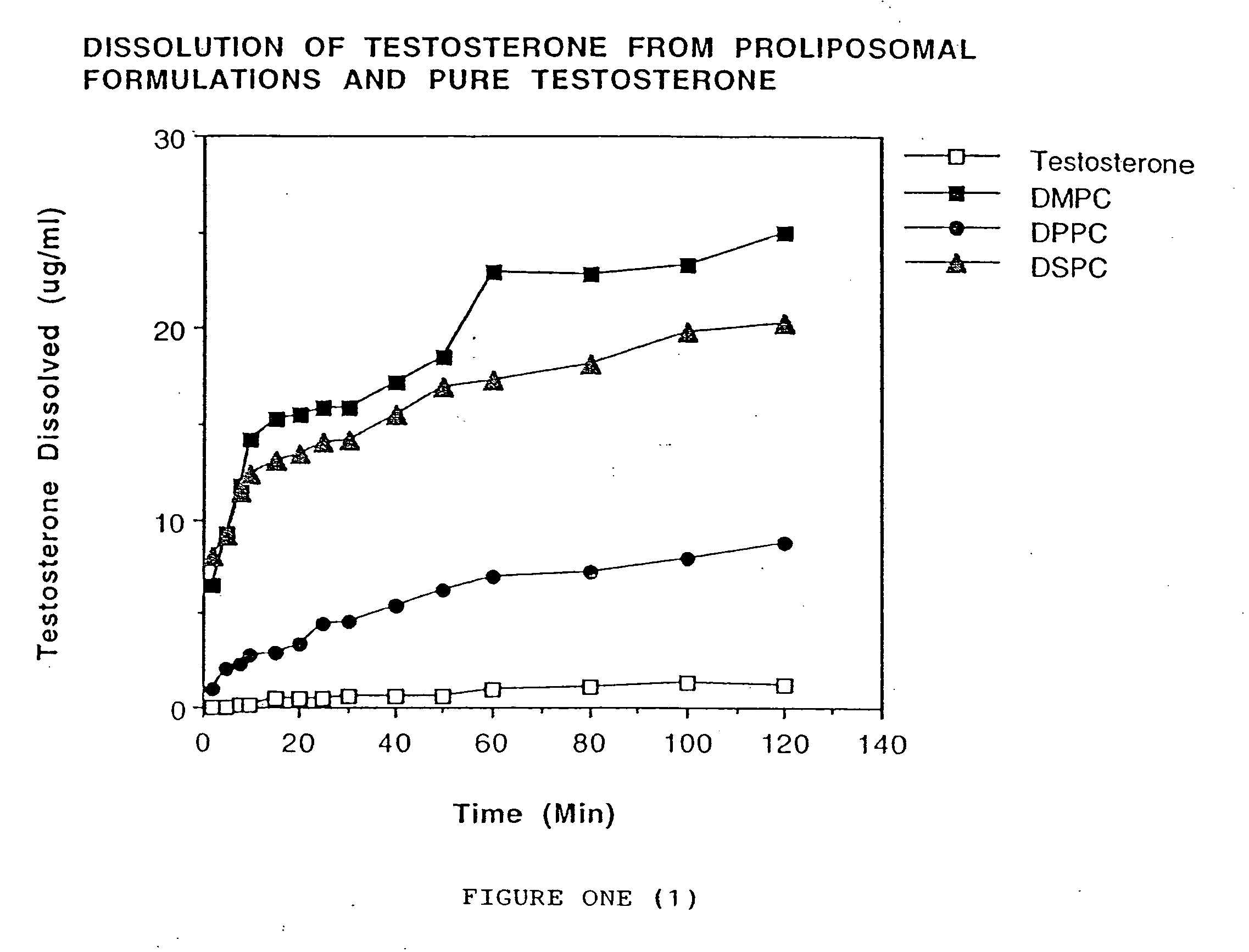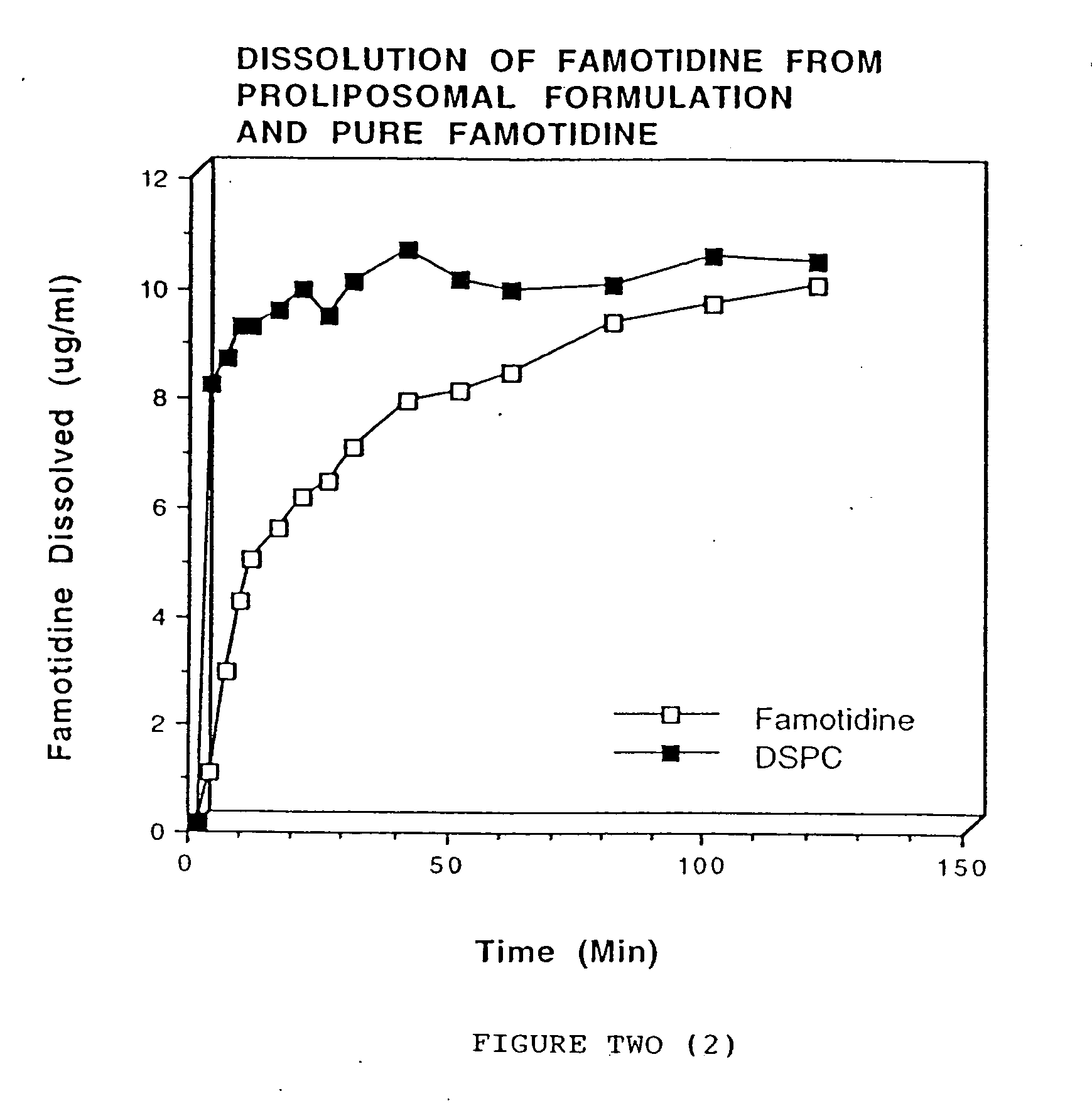Coated drug delivery formulations
a technology of coating and formulation, applied in the direction of drug composition, antiparasitic agents, drug compositions, etc., can solve the problems of ineffective delivery of drugs, limited use of previous systems for orally administering labile pharmacological substances, inadequate shelf life of systems, etc., to improve drug absorption, stability and bioavailability, and enhance drug delivery
- Summary
- Abstract
- Description
- Claims
- Application Information
AI Technical Summary
Benefits of technology
Problems solved by technology
Method used
Image
Examples
example 1
[0070] Halofantrine and distearoyl phosphatidylcholine (1:3 ratio) were dissolved in chloroform and the solvent was evaporated using nitrogen gas. The dry powder was passed through a #60 mesh screen. Cellulose acetate phthalate (50 mg) was dissolved in acetone (6 ml) and sprayed on the halofantrine and distearoyl phosphatidylcholine mixture.
[0071] Dissolution was carried out using 40 mg of the formulation using a Type II USP dissolution apparatus. The dissolution medium (250 ml) was phosphate buffered saline (pH 7.4). The temperature of the dissolution media was maintained at 37±0.5° C. and the rotation of the paddle was set at 50 rpm. Samples (5 ml) were withdrawn at 5, 10, 15, 30, 45, 60, 90, 120, 180 and 240 minutes. Equal volumes of phosphate buffered saline were added to maintain a constant volume of dissolution media.
[0072] The samples were analyzed by high performance liquid chromatography (HPLC). In the mobile phase, 46.5:53.5 (0.025 M potassium phosphate / sulfuric acid / tri...
example 2
[0076] Testosterone and phospholipid (DMPC, DPPC or DSPC; 1:1 ratio) were dissolved in chloroform. Chloroform was evaporated using nitrogen gas. The dry powder was passed using a #60 mesh sieve. Cellulose acetate phthalate (40 mg) was dissolved in acetone (5 ml) and the resulting solution was sprayed on the solid dispersion containing the testosterone and phospholipid. Nitrogen gas was used to dry the powder.
[0077] Dissolution was carried out using 45 mg of the formulation using a Type II USP dissolution apparatus. The dissolution medium (300 ml) was phosphate buffered saline (pH 7.4). The temperature of the dissolution media was maintained at 37±0.5° C. and rotation of the paddle was set at 50 rpm. The samples (5 ml) were withdrawn at 2, 5, 8, 10, 15, 20, 25, 30, 40, 50, 60, 80, 100, and 120 minutes. Equal volumes of phosphate buffered saline were added to maintain a constant volume of dissolution media. Dissolution samples were analyzed by measuring the absorbance at 254 nm.
[007...
example 3
[0082] One embodiment of the present invention was compared to a control method for producing pharmaceutical formulations. The control method used in the following examples is disclosed by Ganter in U.S. Pat. No. 5,635,206, herein incorporated by reference, at Example 1, except that the percentage of water used was 5% and 0%. To exemplar drugs which are poorly water soluble were used: glyburide and benzocaine.
[0083] The following tables summarize the protocol used and the results.
TABLE 2Protocol Materials Used In Comparison Studies of GlyburideQuantity Used InQuantity Used InQuantity UsedControl MethodControl MethodIn Applicant'sMaterialUsing 5% WaterUsing 0% WaterMethodGlyburide12%12%12%Lecithin (DMPC)63%63%63%Water 5% 0% 0%Ethanol20%25%25%
[0084]
TABLE 3Protocol Materials Used In Comparison Studies of Benzocaine.Quantity Used InQuantity Used InQuantity UsedControl MethodControl MethodIn Applicant'sMaterialUsing 5% WaterUsing 0% WaterMethodBenzocaine12%12%12%Lecithin (DMPC)63%63%6...
PUM
| Property | Measurement | Unit |
|---|---|---|
| pH | aaaaa | aaaaa |
| temperature | aaaaa | aaaaa |
| wavelength | aaaaa | aaaaa |
Abstract
Description
Claims
Application Information
 Login to View More
Login to View More - R&D
- Intellectual Property
- Life Sciences
- Materials
- Tech Scout
- Unparalleled Data Quality
- Higher Quality Content
- 60% Fewer Hallucinations
Browse by: Latest US Patents, China's latest patents, Technical Efficacy Thesaurus, Application Domain, Technology Topic, Popular Technical Reports.
© 2025 PatSnap. All rights reserved.Legal|Privacy policy|Modern Slavery Act Transparency Statement|Sitemap|About US| Contact US: help@patsnap.com


